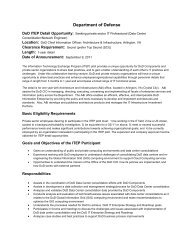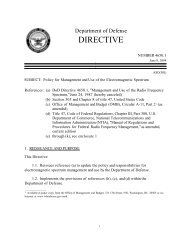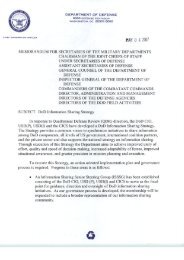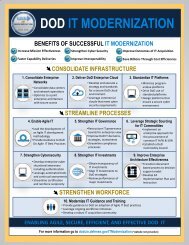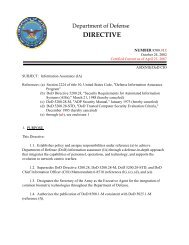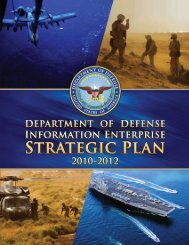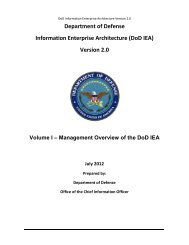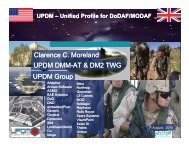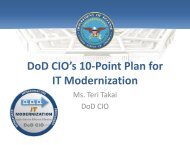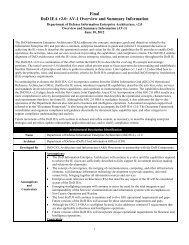DoD Architecture Framework Version 1.5 - Chief Information Officer
DoD Architecture Framework Version 1.5 - Chief Information Officer
DoD Architecture Framework Version 1.5 - Chief Information Officer
Create successful ePaper yourself
Turn your PDF publications into a flip-book with our unique Google optimized e-Paper software.
1.2 SCOPE OF DODAF v<strong>1.5</strong><br />
NCO requires that information and the ability to share information when it is needed, where<br />
it is needed, and with those who need it is critical to enabling transformation. The <strong>DoD</strong>AF V<strong>1.5</strong><br />
supports transformation goals by providing net-centric guidance for describing architecture<br />
artifacts consistently across all mission operations and processes, and enabling the integration<br />
and/or federation of architectures in support of joint capabilities. <strong>DoD</strong>AF v<strong>1.5</strong> begins to<br />
transition its focus away from architecture products (“product-centric”) as seen in v1.0 and aims<br />
toward a greater emphasis on architecture data (“data-centric”). A “data-centric” approach<br />
provides a more flexible and adaptable framework for architecting net-centric, integrated, and/or<br />
federated architectures.<br />
<strong>Version</strong> <strong>1.5</strong> is the first phase in transforming the <strong>DoD</strong>AF and is intended to address concerns<br />
and desires from the architecture community in a timely manner, while allowing for more<br />
revolutionary improvements in subsequent releases. More complex and substantial topics being<br />
scoped for subsequent <strong>DoD</strong>AF versions include:<br />
• Robust inclusion/enhancements to address SOA<br />
• Increased guidance on describing changes in culture, doctrine, and processes<br />
resulting from NCO<br />
• Increased support for data-centric architecture management, including data<br />
visualization via extractions to address decision system support and portfolio<br />
management (PfM) activities<br />
• Additional guidance and examples to better address the development and use<br />
of Enterprise <strong>Architecture</strong> in aligning with the Federal and <strong>DoD</strong> Enterprise<br />
<strong>Architecture</strong>s 6<br />
• Streamlining of the architecture development process to enable more rapid<br />
fielding and agility<br />
• Other fundamental architecture issues, such as security, systems engineering,<br />
tools, and methodology recommendations<br />
1.2.1 Net-Centric <strong>Architecture</strong>s<br />
In the March 2005 National Defense Strategy, the <strong>DoD</strong> restated its commitment towards netcentricity<br />
and NCO. In this paradigm, the NCE, and its associated information and capabilities,<br />
are leveraged as a key component for carrying out missions. The GIG, the “globally<br />
interconnected, end-to-end set of information, capabilities, associated processes, and personnel<br />
for collecting, processing, storing, disseminating, and managing information on demand to<br />
warfighters, policy makers, and support personnel” is the foundation for this environment.<br />
Because of this shift towards net-centricity and the need to effectively develop and manage the<br />
GIG, it becomes necessary for architectures to consistently capture net-centric concepts so as to<br />
afford their accountability in transition planning, implementation, and decision making.<br />
Consistent representation of net-centric concepts aligns with the goals of integrated and/or<br />
federated architectures.<br />
6 Department of Defense Enterprise <strong>Architecture</strong>, http://www.army.mil/escc/cpi/refmod4b.htm<br />
1-2




